Operations and Project Management in Bakkavor and Portakabin
VerifiedAdded on 2023/01/19
|19
|4593
|87
AI Summary
This document discusses the principles of operations management and continuous improvement plans in Bakkavor, a manufacturer of fresh prepared food, and Portakabin, a modular building company. It covers topics such as lean principles, cost reduction, quality improvement, and effective delivery.
Contribute Materials
Your contribution can guide someone’s learning journey. Share your
documents today.

OPERATIONS AND
PROJECT
MANAGEMENT
PROJECT
MANAGEMENT
Secure Best Marks with AI Grader
Need help grading? Try our AI Grader for instant feedback on your assignments.
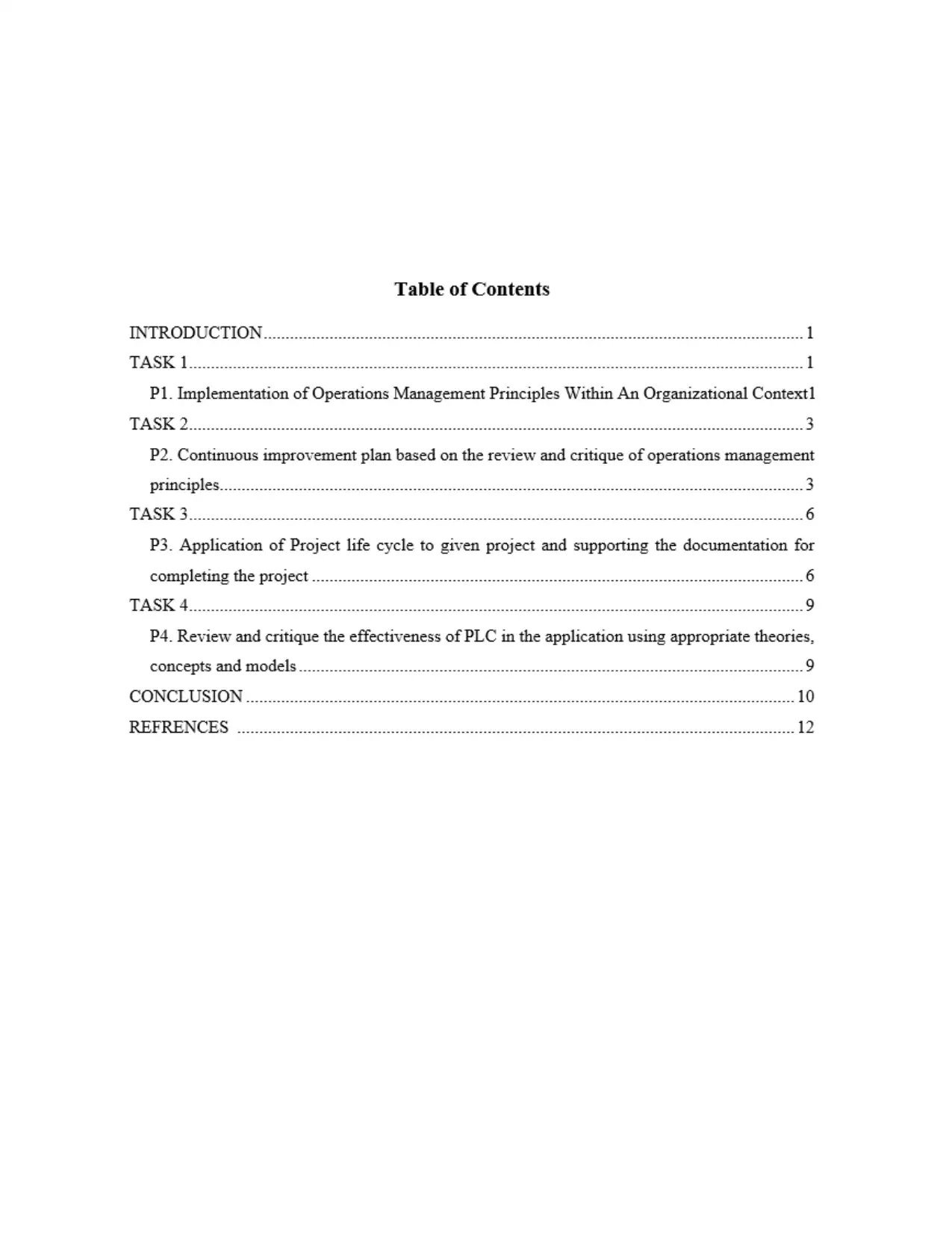
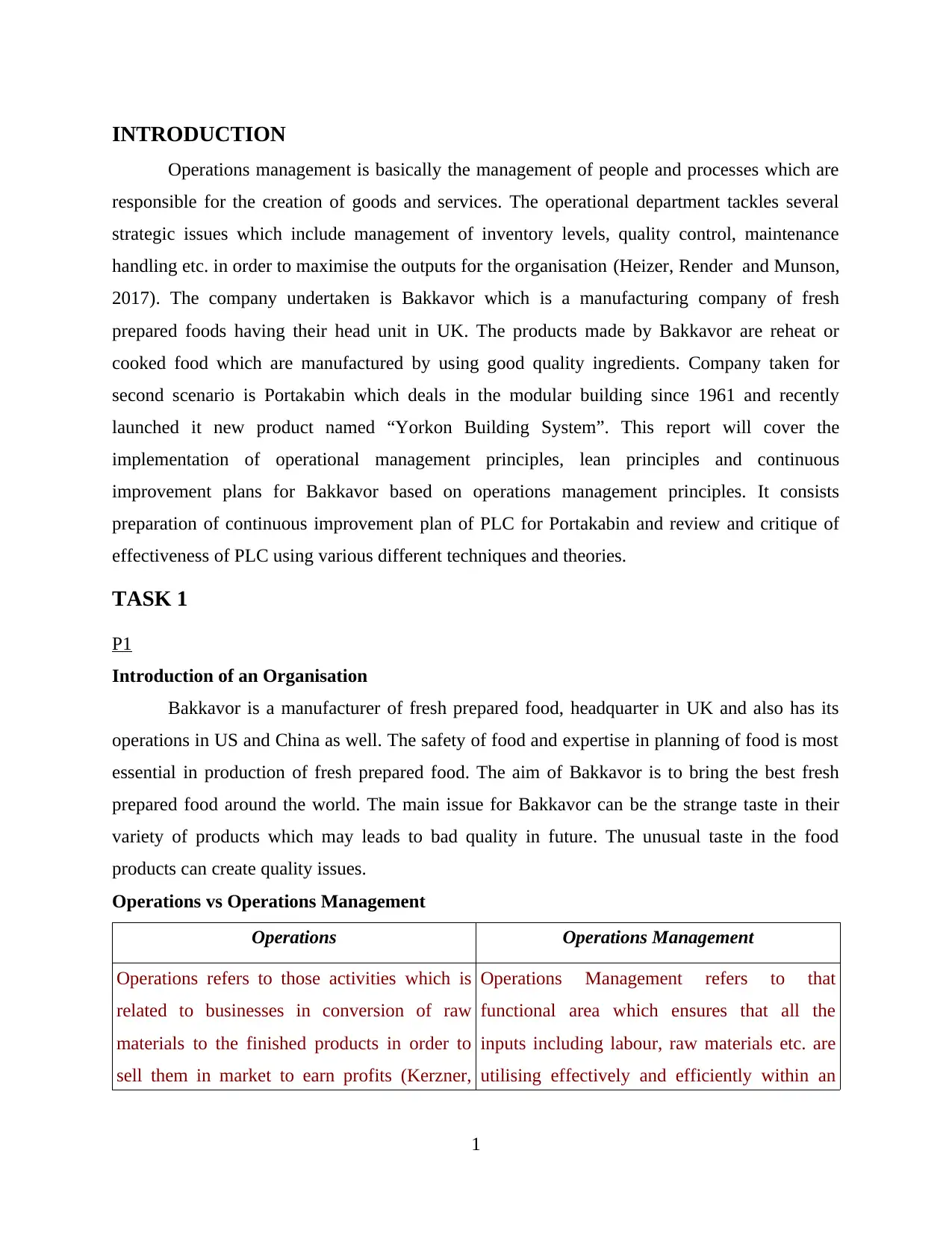
INTRODUCTION
Operations management is basically the management of people and processes which are
responsible for the creation of goods and services. The operational department tackles several
strategic issues which include management of inventory levels, quality control, maintenance
handling etc. in order to maximise the outputs for the organisation (Heizer, Render and Munson,
2017). The company undertaken is Bakkavor which is a manufacturing company of fresh
prepared foods having their head unit in UK. The products made by Bakkavor are reheat or
cooked food which are manufactured by using good quality ingredients. Company taken for
second scenario is Portakabin which deals in the modular building since 1961 and recently
launched it new product named “Yorkon Building System”. This report will cover the
implementation of operational management principles, lean principles and continuous
improvement plans for Bakkavor based on operations management principles. It consists
preparation of continuous improvement plan of PLC for Portakabin and review and critique of
effectiveness of PLC using various different techniques and theories.
TASK 1
P1
Introduction of an Organisation
Bakkavor is a manufacturer of fresh prepared food, headquarter in UK and also has its
operations in US and China as well. The safety of food and expertise in planning of food is most
essential in production of fresh prepared food. The aim of Bakkavor is to bring the best fresh
prepared food around the world. The main issue for Bakkavor can be the strange taste in their
variety of products which may leads to bad quality in future. The unusual taste in the food
products can create quality issues.
Operations vs Operations Management
Operations Operations Management
Operations refers to those activities which is
related to businesses in conversion of raw
materials to the finished products in order to
sell them in market to earn profits (Kerzner,
Operations Management refers to that
functional area which ensures that all the
inputs including labour, raw materials etc. are
utilising effectively and efficiently within an
1
Operations management is basically the management of people and processes which are
responsible for the creation of goods and services. The operational department tackles several
strategic issues which include management of inventory levels, quality control, maintenance
handling etc. in order to maximise the outputs for the organisation (Heizer, Render and Munson,
2017). The company undertaken is Bakkavor which is a manufacturing company of fresh
prepared foods having their head unit in UK. The products made by Bakkavor are reheat or
cooked food which are manufactured by using good quality ingredients. Company taken for
second scenario is Portakabin which deals in the modular building since 1961 and recently
launched it new product named “Yorkon Building System”. This report will cover the
implementation of operational management principles, lean principles and continuous
improvement plans for Bakkavor based on operations management principles. It consists
preparation of continuous improvement plan of PLC for Portakabin and review and critique of
effectiveness of PLC using various different techniques and theories.
TASK 1
P1
Introduction of an Organisation
Bakkavor is a manufacturer of fresh prepared food, headquarter in UK and also has its
operations in US and China as well. The safety of food and expertise in planning of food is most
essential in production of fresh prepared food. The aim of Bakkavor is to bring the best fresh
prepared food around the world. The main issue for Bakkavor can be the strange taste in their
variety of products which may leads to bad quality in future. The unusual taste in the food
products can create quality issues.
Operations vs Operations Management
Operations Operations Management
Operations refers to those activities which is
related to businesses in conversion of raw
materials to the finished products in order to
sell them in market to earn profits (Kerzner,
Operations Management refers to that
functional area which ensures that all the
inputs including labour, raw materials etc. are
utilising effectively and efficiently within an
1
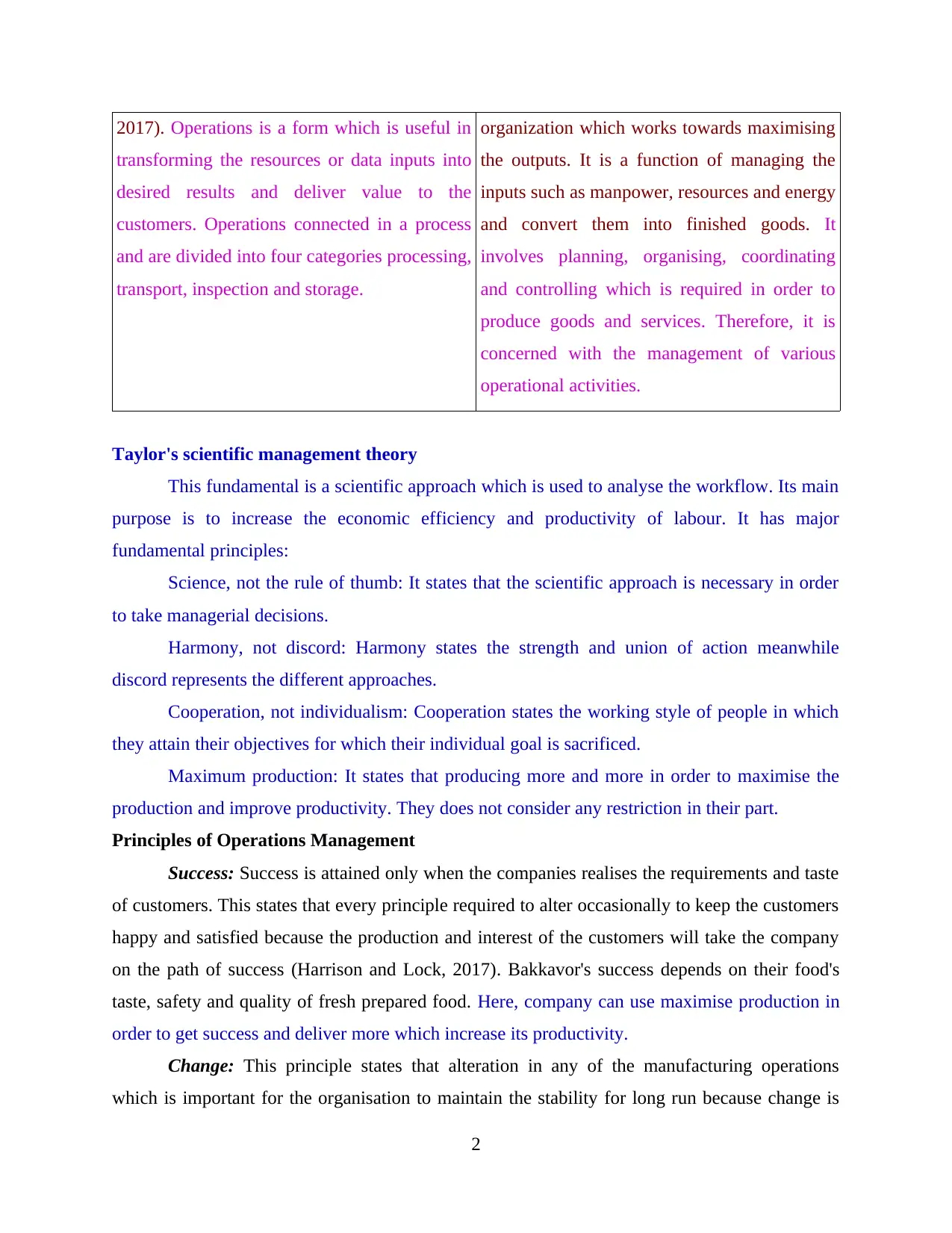
2017). Operations is a form which is useful in
transforming the resources or data inputs into
desired results and deliver value to the
customers. Operations connected in a process
and are divided into four categories processing,
transport, inspection and storage.
organization which works towards maximising
the outputs. It is a function of managing the
inputs such as manpower, resources and energy
and convert them into finished goods. It
involves planning, organising, coordinating
and controlling which is required in order to
produce goods and services. Therefore, it is
concerned with the management of various
operational activities.
Taylor's scientific management theory
This fundamental is a scientific approach which is used to analyse the workflow. Its main
purpose is to increase the economic efficiency and productivity of labour. It has major
fundamental principles:
Science, not the rule of thumb: It states that the scientific approach is necessary in order
to take managerial decisions.
Harmony, not discord: Harmony states the strength and union of action meanwhile
discord represents the different approaches.
Cooperation, not individualism: Cooperation states the working style of people in which
they attain their objectives for which their individual goal is sacrificed.
Maximum production: It states that producing more and more in order to maximise the
production and improve productivity. They does not consider any restriction in their part.
Principles of Operations Management
Success: Success is attained only when the companies realises the requirements and taste
of customers. This states that every principle required to alter occasionally to keep the customers
happy and satisfied because the production and interest of the customers will take the company
on the path of success (Harrison and Lock, 2017). Bakkavor's success depends on their food's
taste, safety and quality of fresh prepared food. Here, company can use maximise production in
order to get success and deliver more which increase its productivity.
Change: This principle states that alteration in any of the manufacturing operations
which is important for the organisation to maintain the stability for long run because change is
2
transforming the resources or data inputs into
desired results and deliver value to the
customers. Operations connected in a process
and are divided into four categories processing,
transport, inspection and storage.
organization which works towards maximising
the outputs. It is a function of managing the
inputs such as manpower, resources and energy
and convert them into finished goods. It
involves planning, organising, coordinating
and controlling which is required in order to
produce goods and services. Therefore, it is
concerned with the management of various
operational activities.
Taylor's scientific management theory
This fundamental is a scientific approach which is used to analyse the workflow. Its main
purpose is to increase the economic efficiency and productivity of labour. It has major
fundamental principles:
Science, not the rule of thumb: It states that the scientific approach is necessary in order
to take managerial decisions.
Harmony, not discord: Harmony states the strength and union of action meanwhile
discord represents the different approaches.
Cooperation, not individualism: Cooperation states the working style of people in which
they attain their objectives for which their individual goal is sacrificed.
Maximum production: It states that producing more and more in order to maximise the
production and improve productivity. They does not consider any restriction in their part.
Principles of Operations Management
Success: Success is attained only when the companies realises the requirements and taste
of customers. This states that every principle required to alter occasionally to keep the customers
happy and satisfied because the production and interest of the customers will take the company
on the path of success (Harrison and Lock, 2017). Bakkavor's success depends on their food's
taste, safety and quality of fresh prepared food. Here, company can use maximise production in
order to get success and deliver more which increase its productivity.
Change: This principle states that alteration in any of the manufacturing operations
which is important for the organisation to maintain the stability for long run because change is
2
Secure Best Marks with AI Grader
Need help grading? Try our AI Grader for instant feedback on your assignments.
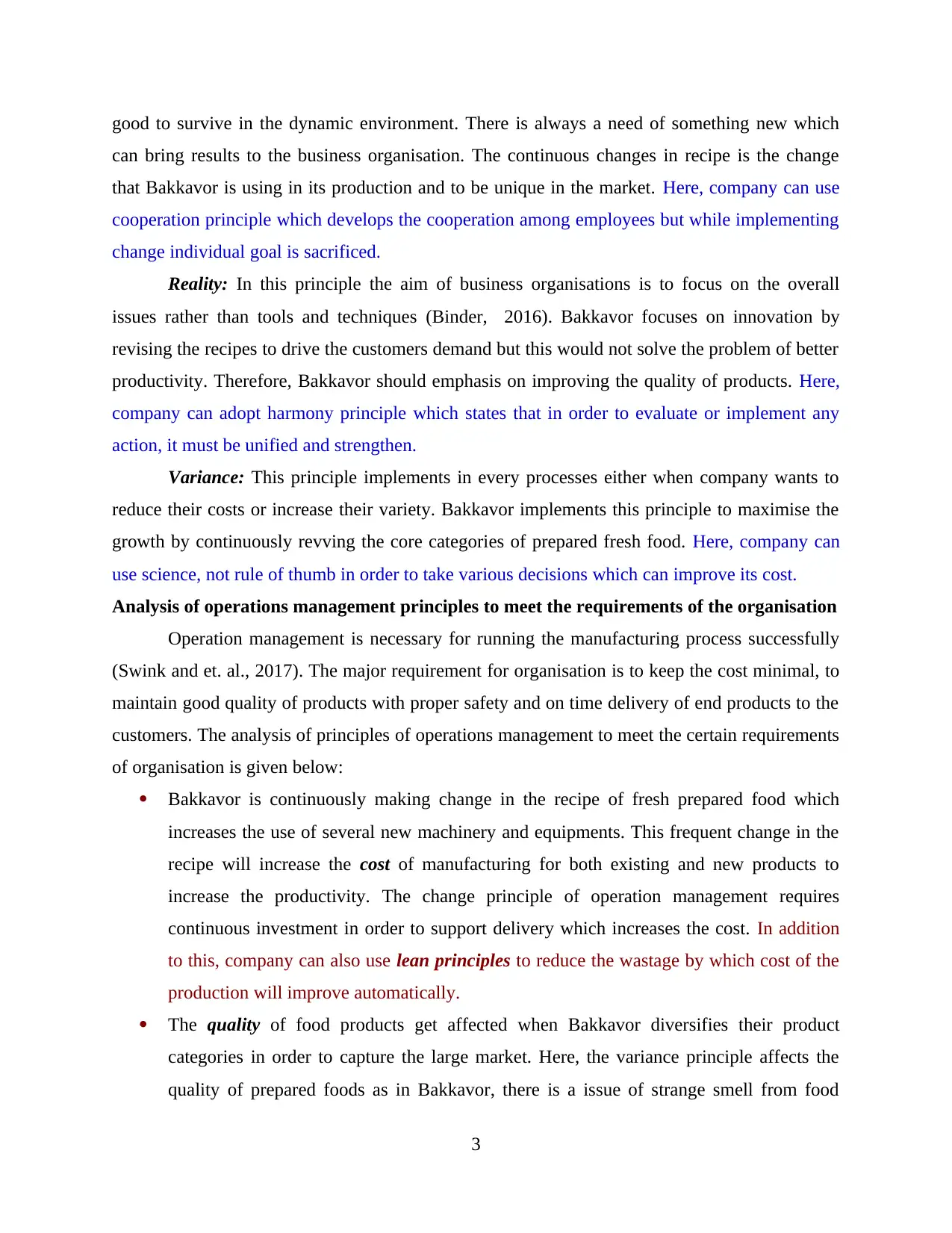
good to survive in the dynamic environment. There is always a need of something new which
can bring results to the business organisation. The continuous changes in recipe is the change
that Bakkavor is using in its production and to be unique in the market. Here, company can use
cooperation principle which develops the cooperation among employees but while implementing
change individual goal is sacrificed.
Reality: In this principle the aim of business organisations is to focus on the overall
issues rather than tools and techniques (Binder, 2016). Bakkavor focuses on innovation by
revising the recipes to drive the customers demand but this would not solve the problem of better
productivity. Therefore, Bakkavor should emphasis on improving the quality of products. Here,
company can adopt harmony principle which states that in order to evaluate or implement any
action, it must be unified and strengthen.
Variance: This principle implements in every processes either when company wants to
reduce their costs or increase their variety. Bakkavor implements this principle to maximise the
growth by continuously revving the core categories of prepared fresh food. Here, company can
use science, not rule of thumb in order to take various decisions which can improve its cost.
Analysis of operations management principles to meet the requirements of the organisation
Operation management is necessary for running the manufacturing process successfully
(Swink and et. al., 2017). The major requirement for organisation is to keep the cost minimal, to
maintain good quality of products with proper safety and on time delivery of end products to the
customers. The analysis of principles of operations management to meet the certain requirements
of organisation is given below:
Bakkavor is continuously making change in the recipe of fresh prepared food which
increases the use of several new machinery and equipments. This frequent change in the
recipe will increase the cost of manufacturing for both existing and new products to
increase the productivity. The change principle of operation management requires
continuous investment in order to support delivery which increases the cost. In addition
to this, company can also use lean principles to reduce the wastage by which cost of the
production will improve automatically.
The quality of food products get affected when Bakkavor diversifies their product
categories in order to capture the large market. Here, the variance principle affects the
quality of prepared foods as in Bakkavor, there is a issue of strange smell from food
3
can bring results to the business organisation. The continuous changes in recipe is the change
that Bakkavor is using in its production and to be unique in the market. Here, company can use
cooperation principle which develops the cooperation among employees but while implementing
change individual goal is sacrificed.
Reality: In this principle the aim of business organisations is to focus on the overall
issues rather than tools and techniques (Binder, 2016). Bakkavor focuses on innovation by
revising the recipes to drive the customers demand but this would not solve the problem of better
productivity. Therefore, Bakkavor should emphasis on improving the quality of products. Here,
company can adopt harmony principle which states that in order to evaluate or implement any
action, it must be unified and strengthen.
Variance: This principle implements in every processes either when company wants to
reduce their costs or increase their variety. Bakkavor implements this principle to maximise the
growth by continuously revving the core categories of prepared fresh food. Here, company can
use science, not rule of thumb in order to take various decisions which can improve its cost.
Analysis of operations management principles to meet the requirements of the organisation
Operation management is necessary for running the manufacturing process successfully
(Swink and et. al., 2017). The major requirement for organisation is to keep the cost minimal, to
maintain good quality of products with proper safety and on time delivery of end products to the
customers. The analysis of principles of operations management to meet the certain requirements
of organisation is given below:
Bakkavor is continuously making change in the recipe of fresh prepared food which
increases the use of several new machinery and equipments. This frequent change in the
recipe will increase the cost of manufacturing for both existing and new products to
increase the productivity. The change principle of operation management requires
continuous investment in order to support delivery which increases the cost. In addition
to this, company can also use lean principles to reduce the wastage by which cost of the
production will improve automatically.
The quality of food products get affected when Bakkavor diversifies their product
categories in order to capture the large market. Here, the variance principle affects the
quality of prepared foods as in Bakkavor, there is a issue of strange smell from food
3
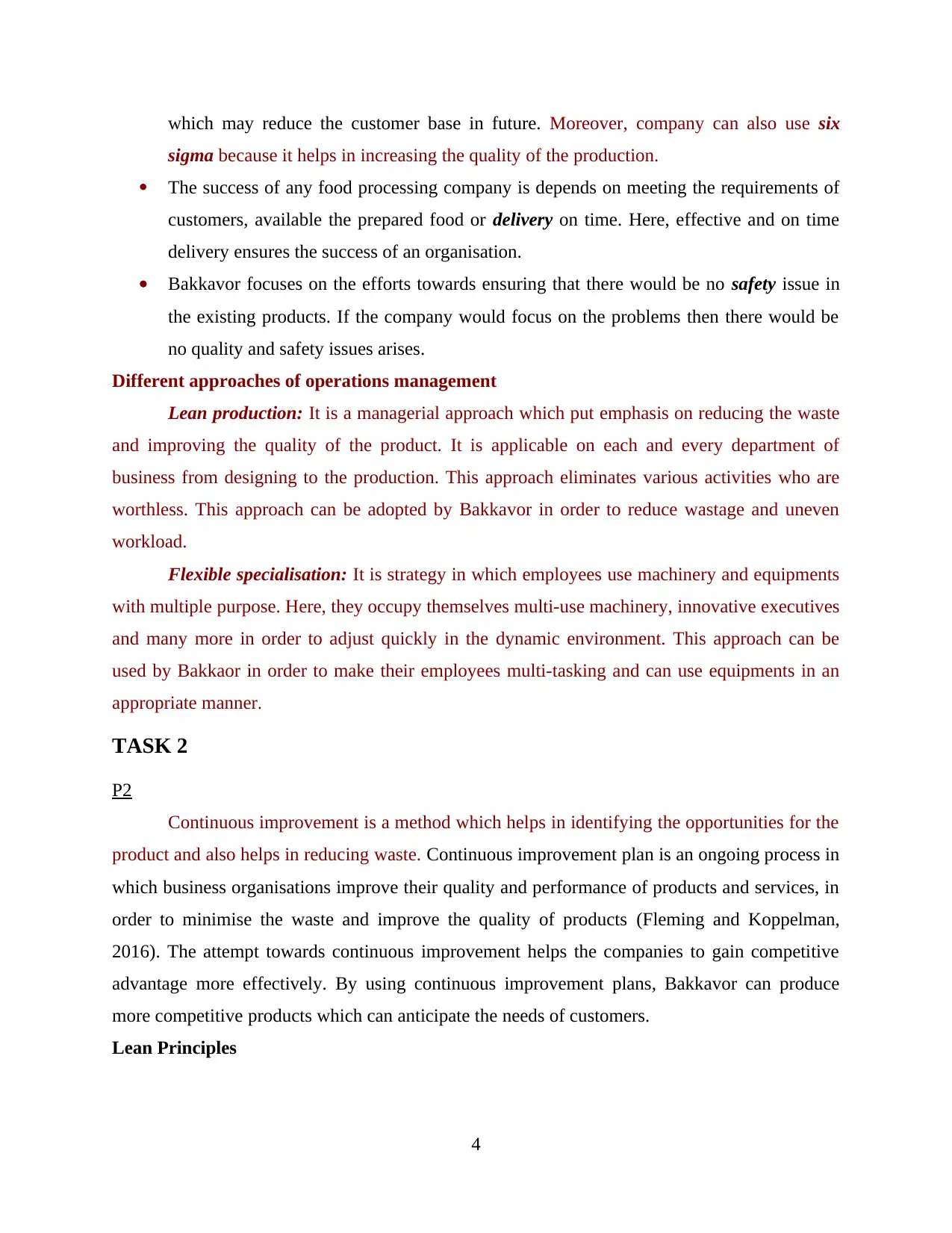
which may reduce the customer base in future. Moreover, company can also use six
sigma because it helps in increasing the quality of the production.
The success of any food processing company is depends on meeting the requirements of
customers, available the prepared food or delivery on time. Here, effective and on time
delivery ensures the success of an organisation.
Bakkavor focuses on the efforts towards ensuring that there would be no safety issue in
the existing products. If the company would focus on the problems then there would be
no quality and safety issues arises.
Different approaches of operations management
Lean production: It is a managerial approach which put emphasis on reducing the waste
and improving the quality of the product. It is applicable on each and every department of
business from designing to the production. This approach eliminates various activities who are
worthless. This approach can be adopted by Bakkavor in order to reduce wastage and uneven
workload.
Flexible specialisation: It is strategy in which employees use machinery and equipments
with multiple purpose. Here, they occupy themselves multi-use machinery, innovative executives
and many more in order to adjust quickly in the dynamic environment. This approach can be
used by Bakkaor in order to make their employees multi-tasking and can use equipments in an
appropriate manner.
TASK 2
P2
Continuous improvement is a method which helps in identifying the opportunities for the
product and also helps in reducing waste. Continuous improvement plan is an ongoing process in
which business organisations improve their quality and performance of products and services, in
order to minimise the waste and improve the quality of products (Fleming and Koppelman,
2016). The attempt towards continuous improvement helps the companies to gain competitive
advantage more effectively. By using continuous improvement plans, Bakkavor can produce
more competitive products which can anticipate the needs of customers.
Lean Principles
4
sigma because it helps in increasing the quality of the production.
The success of any food processing company is depends on meeting the requirements of
customers, available the prepared food or delivery on time. Here, effective and on time
delivery ensures the success of an organisation.
Bakkavor focuses on the efforts towards ensuring that there would be no safety issue in
the existing products. If the company would focus on the problems then there would be
no quality and safety issues arises.
Different approaches of operations management
Lean production: It is a managerial approach which put emphasis on reducing the waste
and improving the quality of the product. It is applicable on each and every department of
business from designing to the production. This approach eliminates various activities who are
worthless. This approach can be adopted by Bakkavor in order to reduce wastage and uneven
workload.
Flexible specialisation: It is strategy in which employees use machinery and equipments
with multiple purpose. Here, they occupy themselves multi-use machinery, innovative executives
and many more in order to adjust quickly in the dynamic environment. This approach can be
used by Bakkaor in order to make their employees multi-tasking and can use equipments in an
appropriate manner.
TASK 2
P2
Continuous improvement is a method which helps in identifying the opportunities for the
product and also helps in reducing waste. Continuous improvement plan is an ongoing process in
which business organisations improve their quality and performance of products and services, in
order to minimise the waste and improve the quality of products (Fleming and Koppelman,
2016). The attempt towards continuous improvement helps the companies to gain competitive
advantage more effectively. By using continuous improvement plans, Bakkavor can produce
more competitive products which can anticipate the needs of customers.
Lean Principles
4
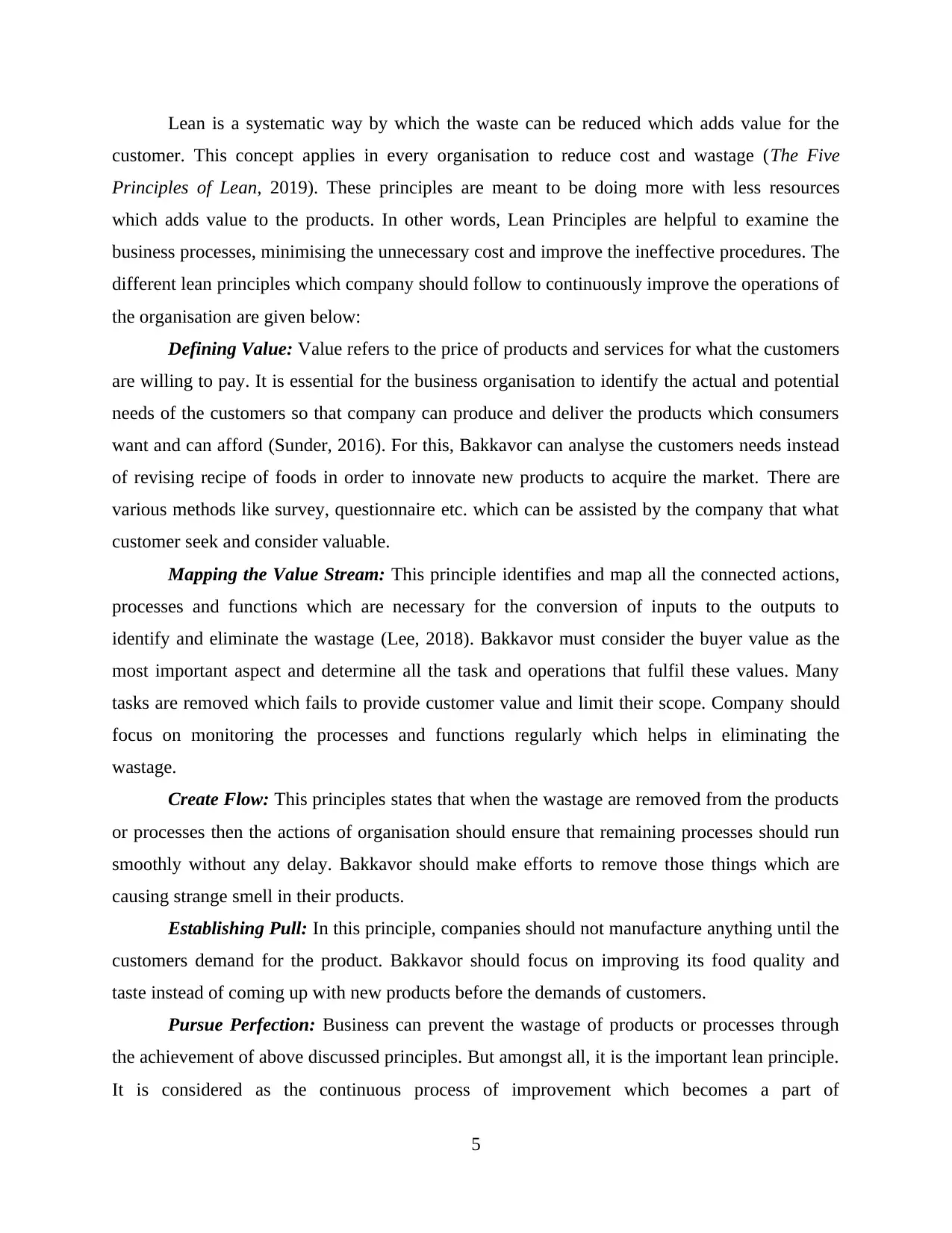
Lean is a systematic way by which the waste can be reduced which adds value for the
customer. This concept applies in every organisation to reduce cost and wastage (The Five
Principles of Lean, 2019). These principles are meant to be doing more with less resources
which adds value to the products. In other words, Lean Principles are helpful to examine the
business processes, minimising the unnecessary cost and improve the ineffective procedures. The
different lean principles which company should follow to continuously improve the operations of
the organisation are given below:
Defining Value: Value refers to the price of products and services for what the customers
are willing to pay. It is essential for the business organisation to identify the actual and potential
needs of the customers so that company can produce and deliver the products which consumers
want and can afford (Sunder, 2016). For this, Bakkavor can analyse the customers needs instead
of revising recipe of foods in order to innovate new products to acquire the market. There are
various methods like survey, questionnaire etc. which can be assisted by the company that what
customer seek and consider valuable.
Mapping the Value Stream: This principle identifies and map all the connected actions,
processes and functions which are necessary for the conversion of inputs to the outputs to
identify and eliminate the wastage (Lee, 2018). Bakkavor must consider the buyer value as the
most important aspect and determine all the task and operations that fulfil these values. Many
tasks are removed which fails to provide customer value and limit their scope. Company should
focus on monitoring the processes and functions regularly which helps in eliminating the
wastage.
Create Flow: This principles states that when the wastage are removed from the products
or processes then the actions of organisation should ensure that remaining processes should run
smoothly without any delay. Bakkavor should make efforts to remove those things which are
causing strange smell in their products.
Establishing Pull: In this principle, companies should not manufacture anything until the
customers demand for the product. Bakkavor should focus on improving its food quality and
taste instead of coming up with new products before the demands of customers.
Pursue Perfection: Business can prevent the wastage of products or processes through
the achievement of above discussed principles. But amongst all, it is the important lean principle.
It is considered as the continuous process of improvement which becomes a part of
5
customer. This concept applies in every organisation to reduce cost and wastage (The Five
Principles of Lean, 2019). These principles are meant to be doing more with less resources
which adds value to the products. In other words, Lean Principles are helpful to examine the
business processes, minimising the unnecessary cost and improve the ineffective procedures. The
different lean principles which company should follow to continuously improve the operations of
the organisation are given below:
Defining Value: Value refers to the price of products and services for what the customers
are willing to pay. It is essential for the business organisation to identify the actual and potential
needs of the customers so that company can produce and deliver the products which consumers
want and can afford (Sunder, 2016). For this, Bakkavor can analyse the customers needs instead
of revising recipe of foods in order to innovate new products to acquire the market. There are
various methods like survey, questionnaire etc. which can be assisted by the company that what
customer seek and consider valuable.
Mapping the Value Stream: This principle identifies and map all the connected actions,
processes and functions which are necessary for the conversion of inputs to the outputs to
identify and eliminate the wastage (Lee, 2018). Bakkavor must consider the buyer value as the
most important aspect and determine all the task and operations that fulfil these values. Many
tasks are removed which fails to provide customer value and limit their scope. Company should
focus on monitoring the processes and functions regularly which helps in eliminating the
wastage.
Create Flow: This principles states that when the wastage are removed from the products
or processes then the actions of organisation should ensure that remaining processes should run
smoothly without any delay. Bakkavor should make efforts to remove those things which are
causing strange smell in their products.
Establishing Pull: In this principle, companies should not manufacture anything until the
customers demand for the product. Bakkavor should focus on improving its food quality and
taste instead of coming up with new products before the demands of customers.
Pursue Perfection: Business can prevent the wastage of products or processes through
the achievement of above discussed principles. But amongst all, it is the important lean principle.
It is considered as the continuous process of improvement which becomes a part of
5
Paraphrase This Document
Need a fresh take? Get an instant paraphrase of this document with our AI Paraphraser
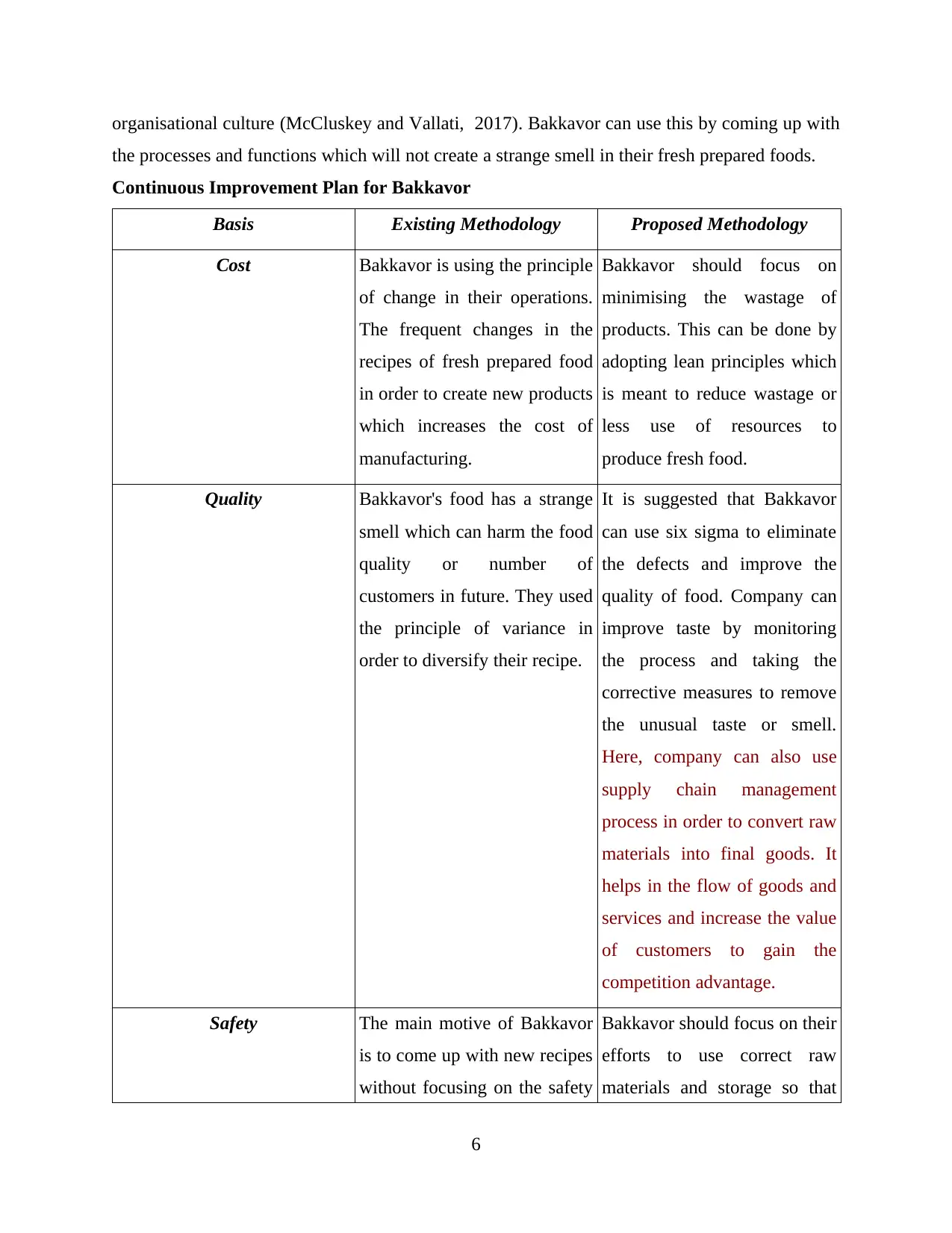
organisational culture (McCluskey and Vallati, 2017). Bakkavor can use this by coming up with
the processes and functions which will not create a strange smell in their fresh prepared foods.
Continuous Improvement Plan for Bakkavor
Basis Existing Methodology Proposed Methodology
Cost Bakkavor is using the principle
of change in their operations.
The frequent changes in the
recipes of fresh prepared food
in order to create new products
which increases the cost of
manufacturing.
Bakkavor should focus on
minimising the wastage of
products. This can be done by
adopting lean principles which
is meant to reduce wastage or
less use of resources to
produce fresh food.
Quality Bakkavor's food has a strange
smell which can harm the food
quality or number of
customers in future. They used
the principle of variance in
order to diversify their recipe.
It is suggested that Bakkavor
can use six sigma to eliminate
the defects and improve the
quality of food. Company can
improve taste by monitoring
the process and taking the
corrective measures to remove
the unusual taste or smell.
Here, company can also use
supply chain management
process in order to convert raw
materials into final goods. It
helps in the flow of goods and
services and increase the value
of customers to gain the
competition advantage.
Safety The main motive of Bakkavor
is to come up with new recipes
without focusing on the safety
Bakkavor should focus on their
efforts to use correct raw
materials and storage so that
6
the processes and functions which will not create a strange smell in their fresh prepared foods.
Continuous Improvement Plan for Bakkavor
Basis Existing Methodology Proposed Methodology
Cost Bakkavor is using the principle
of change in their operations.
The frequent changes in the
recipes of fresh prepared food
in order to create new products
which increases the cost of
manufacturing.
Bakkavor should focus on
minimising the wastage of
products. This can be done by
adopting lean principles which
is meant to reduce wastage or
less use of resources to
produce fresh food.
Quality Bakkavor's food has a strange
smell which can harm the food
quality or number of
customers in future. They used
the principle of variance in
order to diversify their recipe.
It is suggested that Bakkavor
can use six sigma to eliminate
the defects and improve the
quality of food. Company can
improve taste by monitoring
the process and taking the
corrective measures to remove
the unusual taste or smell.
Here, company can also use
supply chain management
process in order to convert raw
materials into final goods. It
helps in the flow of goods and
services and increase the value
of customers to gain the
competition advantage.
Safety The main motive of Bakkavor
is to come up with new recipes
without focusing on the safety
Bakkavor should focus on their
efforts to use correct raw
materials and storage so that
6
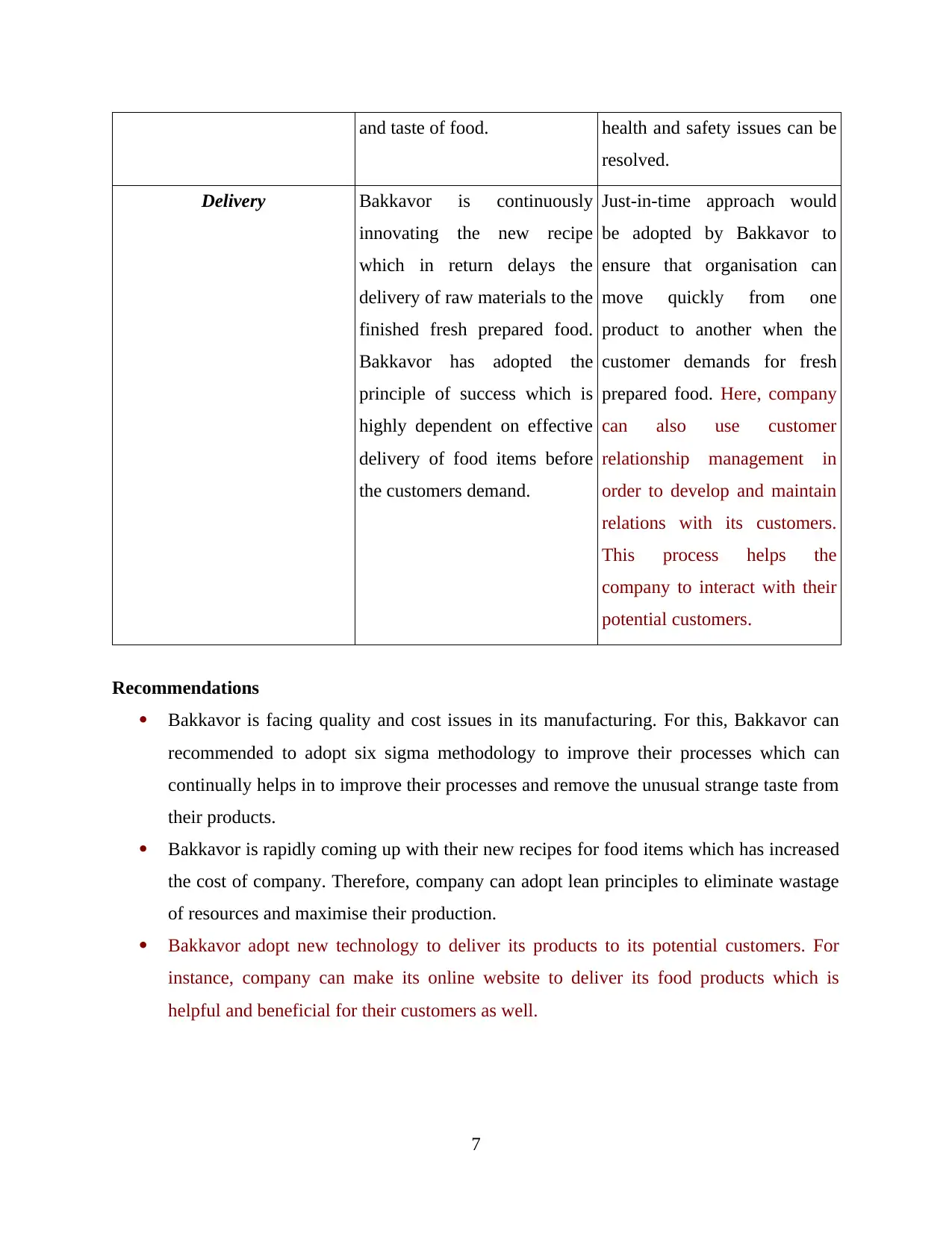
and taste of food. health and safety issues can be
resolved.
Delivery Bakkavor is continuously
innovating the new recipe
which in return delays the
delivery of raw materials to the
finished fresh prepared food.
Bakkavor has adopted the
principle of success which is
highly dependent on effective
delivery of food items before
the customers demand.
Just-in-time approach would
be adopted by Bakkavor to
ensure that organisation can
move quickly from one
product to another when the
customer demands for fresh
prepared food. Here, company
can also use customer
relationship management in
order to develop and maintain
relations with its customers.
This process helps the
company to interact with their
potential customers.
Recommendations
Bakkavor is facing quality and cost issues in its manufacturing. For this, Bakkavor can
recommended to adopt six sigma methodology to improve their processes which can
continually helps in to improve their processes and remove the unusual strange taste from
their products.
Bakkavor is rapidly coming up with their new recipes for food items which has increased
the cost of company. Therefore, company can adopt lean principles to eliminate wastage
of resources and maximise their production.
Bakkavor adopt new technology to deliver its products to its potential customers. For
instance, company can make its online website to deliver its food products which is
helpful and beneficial for their customers as well.
7
resolved.
Delivery Bakkavor is continuously
innovating the new recipe
which in return delays the
delivery of raw materials to the
finished fresh prepared food.
Bakkavor has adopted the
principle of success which is
highly dependent on effective
delivery of food items before
the customers demand.
Just-in-time approach would
be adopted by Bakkavor to
ensure that organisation can
move quickly from one
product to another when the
customer demands for fresh
prepared food. Here, company
can also use customer
relationship management in
order to develop and maintain
relations with its customers.
This process helps the
company to interact with their
potential customers.
Recommendations
Bakkavor is facing quality and cost issues in its manufacturing. For this, Bakkavor can
recommended to adopt six sigma methodology to improve their processes which can
continually helps in to improve their processes and remove the unusual strange taste from
their products.
Bakkavor is rapidly coming up with their new recipes for food items which has increased
the cost of company. Therefore, company can adopt lean principles to eliminate wastage
of resources and maximise their production.
Bakkavor adopt new technology to deliver its products to its potential customers. For
instance, company can make its online website to deliver its food products which is
helpful and beneficial for their customers as well.
7
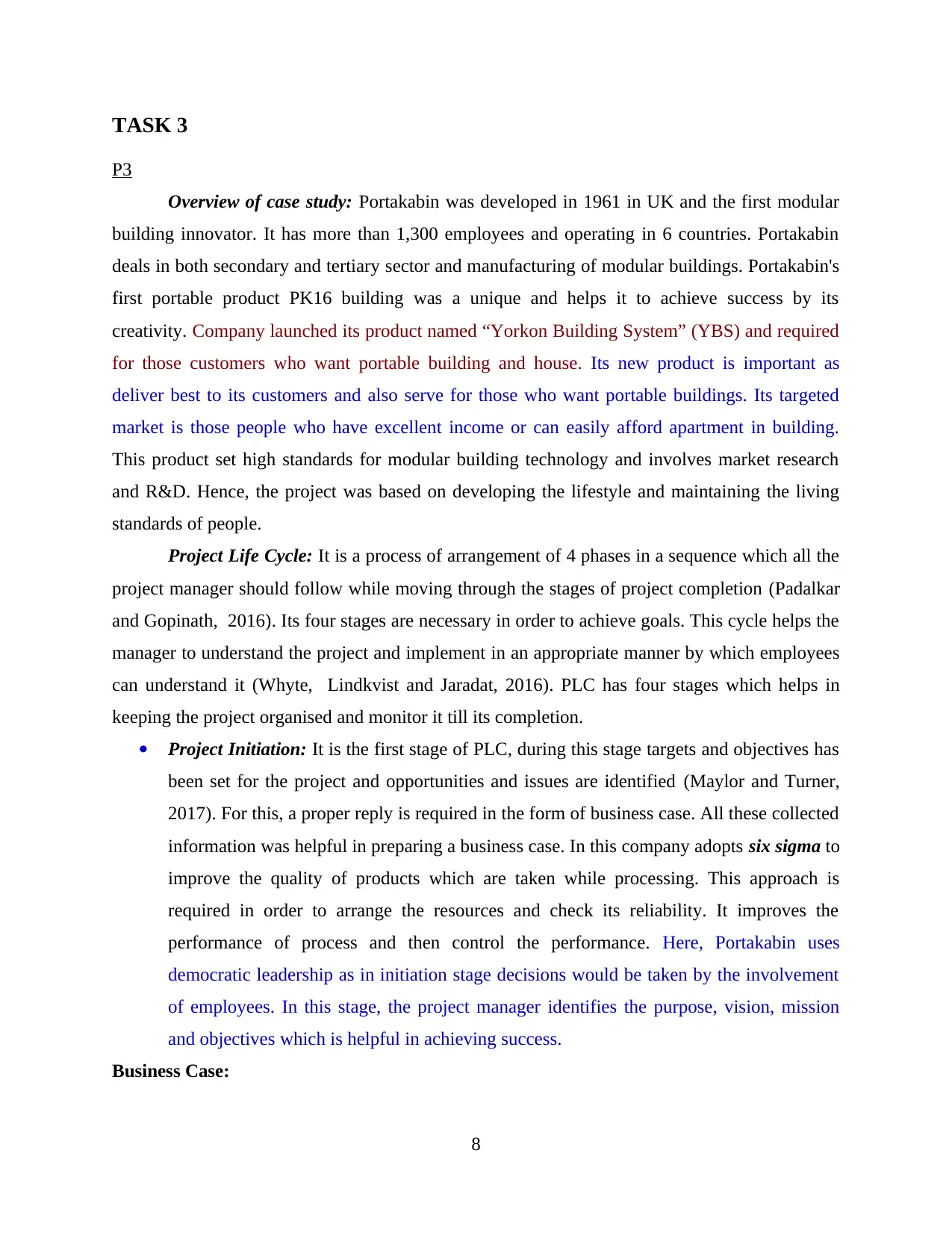
TASK 3
P3
Overview of case study: Portakabin was developed in 1961 in UK and the first modular
building innovator. It has more than 1,300 employees and operating in 6 countries. Portakabin
deals in both secondary and tertiary sector and manufacturing of modular buildings. Portakabin's
first portable product PK16 building was a unique and helps it to achieve success by its
creativity. Company launched its product named “Yorkon Building System” (YBS) and required
for those customers who want portable building and house. Its new product is important as
deliver best to its customers and also serve for those who want portable buildings. Its targeted
market is those people who have excellent income or can easily afford apartment in building.
This product set high standards for modular building technology and involves market research
and R&D. Hence, the project was based on developing the lifestyle and maintaining the living
standards of people.
Project Life Cycle: It is a process of arrangement of 4 phases in a sequence which all the
project manager should follow while moving through the stages of project completion (Padalkar
and Gopinath, 2016). Its four stages are necessary in order to achieve goals. This cycle helps the
manager to understand the project and implement in an appropriate manner by which employees
can understand it (Whyte, Lindkvist and Jaradat, 2016). PLC has four stages which helps in
keeping the project organised and monitor it till its completion.
Project Initiation: It is the first stage of PLC, during this stage targets and objectives has
been set for the project and opportunities and issues are identified (Maylor and Turner,
2017). For this, a proper reply is required in the form of business case. All these collected
information was helpful in preparing a business case. In this company adopts six sigma to
improve the quality of products which are taken while processing. This approach is
required in order to arrange the resources and check its reliability. It improves the
performance of process and then control the performance. Here, Portakabin uses
democratic leadership as in initiation stage decisions would be taken by the involvement
of employees. In this stage, the project manager identifies the purpose, vision, mission
and objectives which is helpful in achieving success.
Business Case:
8
P3
Overview of case study: Portakabin was developed in 1961 in UK and the first modular
building innovator. It has more than 1,300 employees and operating in 6 countries. Portakabin
deals in both secondary and tertiary sector and manufacturing of modular buildings. Portakabin's
first portable product PK16 building was a unique and helps it to achieve success by its
creativity. Company launched its product named “Yorkon Building System” (YBS) and required
for those customers who want portable building and house. Its new product is important as
deliver best to its customers and also serve for those who want portable buildings. Its targeted
market is those people who have excellent income or can easily afford apartment in building.
This product set high standards for modular building technology and involves market research
and R&D. Hence, the project was based on developing the lifestyle and maintaining the living
standards of people.
Project Life Cycle: It is a process of arrangement of 4 phases in a sequence which all the
project manager should follow while moving through the stages of project completion (Padalkar
and Gopinath, 2016). Its four stages are necessary in order to achieve goals. This cycle helps the
manager to understand the project and implement in an appropriate manner by which employees
can understand it (Whyte, Lindkvist and Jaradat, 2016). PLC has four stages which helps in
keeping the project organised and monitor it till its completion.
Project Initiation: It is the first stage of PLC, during this stage targets and objectives has
been set for the project and opportunities and issues are identified (Maylor and Turner,
2017). For this, a proper reply is required in the form of business case. All these collected
information was helpful in preparing a business case. In this company adopts six sigma to
improve the quality of products which are taken while processing. This approach is
required in order to arrange the resources and check its reliability. It improves the
performance of process and then control the performance. Here, Portakabin uses
democratic leadership as in initiation stage decisions would be taken by the involvement
of employees. In this stage, the project manager identifies the purpose, vision, mission
and objectives which is helpful in achieving success.
Business Case:
8
Secure Best Marks with AI Grader
Need help grading? Try our AI Grader for instant feedback on your assignments.

Company Overview Portakabin deals in the manufacturing of modular buildings situated
in York, UK. Company introduced its first product in 1961 named
PK16 which is the unique product at that time and helps the company
to achieve growth.
Vision and Mission Company's vision is clear that they want to provide peace to their
customers across UK by providing quality products and services.
Their mission is to demonstrate itself by acquiring the market of
portable buildings and achieve service excellence by its experience.
Objectives The objective of Portakabin by its product “Yorkon Building
System” is to cut the competition in modular building technology to
gain the more market segment and create a positive social impact in
the eyes of people.
Strategies While developing its product, Portakabin designs some strategies for
the better implementation and execution. Company make plans
which are based on the market research and R&D.
Project Planning: In this stage the objectives and issues are taken into consideration and
a series of actionable tasks in which potential issues are addressed (Kasemsap, 2018). In
this a schedule is prepared for the completion of task. The project manager make sure that
they create smaller goals for the large projects in order to achieve them easily. In this
stage, manager adopts lean principles while making plans in order to reduce the wastage
and optimum utilisation of available resources. In this stage, Portakabin will apply
autocratic leadership because if in planning stage manager involves subordinates then
conflicts can arise due to different opinions and perspective.
Project Plan:
Cost The approximately cost which company uses while developing its
product £96,800 as external resources and equipments are required to
develop a project.
Quality Company focuses on the quality of raw materials which they use to
9
in York, UK. Company introduced its first product in 1961 named
PK16 which is the unique product at that time and helps the company
to achieve growth.
Vision and Mission Company's vision is clear that they want to provide peace to their
customers across UK by providing quality products and services.
Their mission is to demonstrate itself by acquiring the market of
portable buildings and achieve service excellence by its experience.
Objectives The objective of Portakabin by its product “Yorkon Building
System” is to cut the competition in modular building technology to
gain the more market segment and create a positive social impact in
the eyes of people.
Strategies While developing its product, Portakabin designs some strategies for
the better implementation and execution. Company make plans
which are based on the market research and R&D.
Project Planning: In this stage the objectives and issues are taken into consideration and
a series of actionable tasks in which potential issues are addressed (Kasemsap, 2018). In
this a schedule is prepared for the completion of task. The project manager make sure that
they create smaller goals for the large projects in order to achieve them easily. In this
stage, manager adopts lean principles while making plans in order to reduce the wastage
and optimum utilisation of available resources. In this stage, Portakabin will apply
autocratic leadership because if in planning stage manager involves subordinates then
conflicts can arise due to different opinions and perspective.
Project Plan:
Cost The approximately cost which company uses while developing its
product £96,800 as external resources and equipments are required to
develop a project.
Quality Company focuses on the quality of raw materials which they use to
9
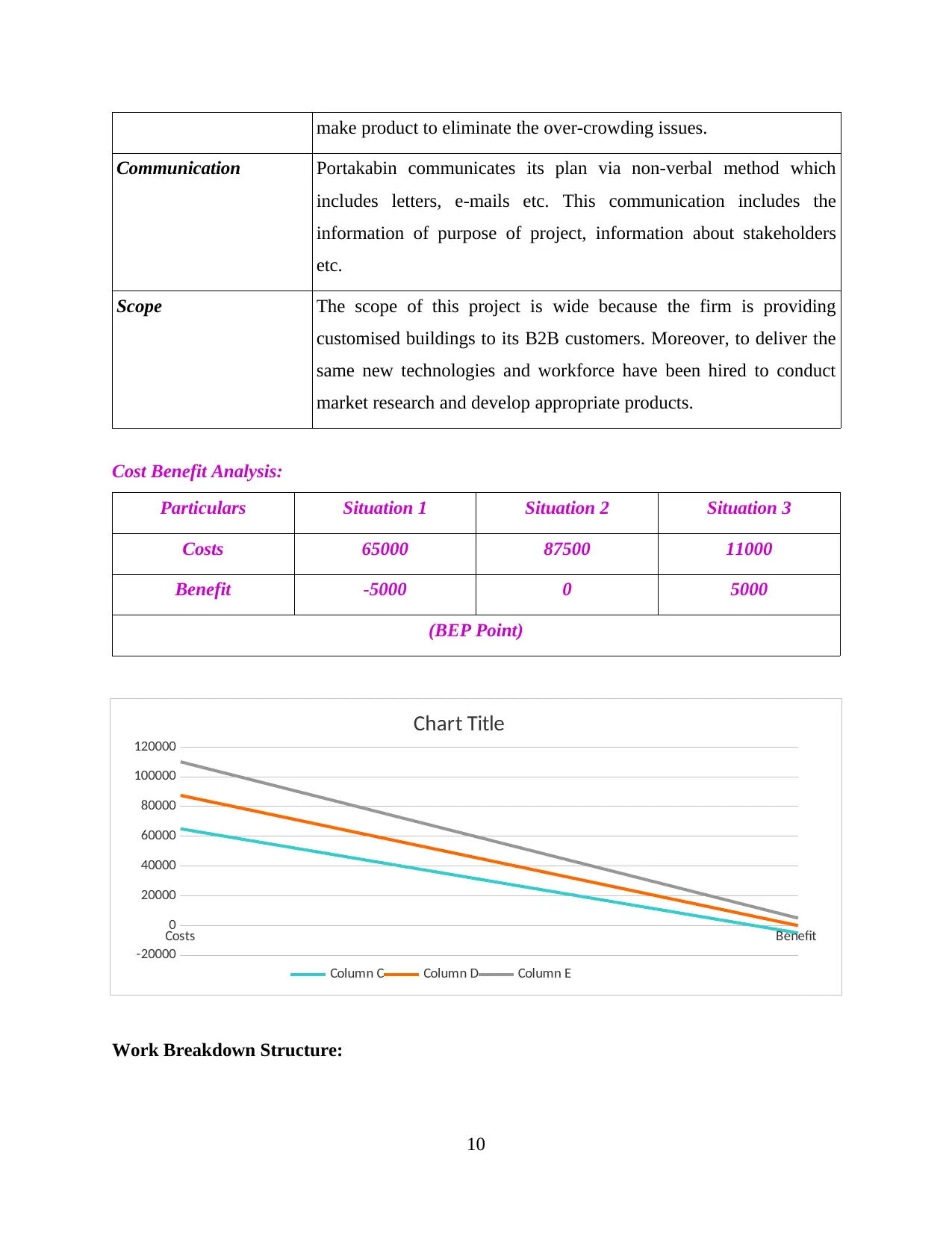
make product to eliminate the over-crowding issues.
Communication Portakabin communicates its plan via non-verbal method which
includes letters, e-mails etc. This communication includes the
information of purpose of project, information about stakeholders
etc.
Scope The scope of this project is wide because the firm is providing
customised buildings to its B2B customers. Moreover, to deliver the
same new technologies and workforce have been hired to conduct
market research and develop appropriate products.
Cost Benefit Analysis:
Particulars Situation 1 Situation 2 Situation 3
Costs 65000 87500 11000
Benefit -5000 0 5000
(BEP Point)
Work Breakdown Structure:
10
Costs Benefit
-20000
0
20000
40000
60000
80000
100000
120000
Chart Title
Column C Column D Column E
Communication Portakabin communicates its plan via non-verbal method which
includes letters, e-mails etc. This communication includes the
information of purpose of project, information about stakeholders
etc.
Scope The scope of this project is wide because the firm is providing
customised buildings to its B2B customers. Moreover, to deliver the
same new technologies and workforce have been hired to conduct
market research and develop appropriate products.
Cost Benefit Analysis:
Particulars Situation 1 Situation 2 Situation 3
Costs 65000 87500 11000
Benefit -5000 0 5000
(BEP Point)
Work Breakdown Structure:
10
Costs Benefit
-20000
0
20000
40000
60000
80000
100000
120000
Chart Title
Column C Column D Column E
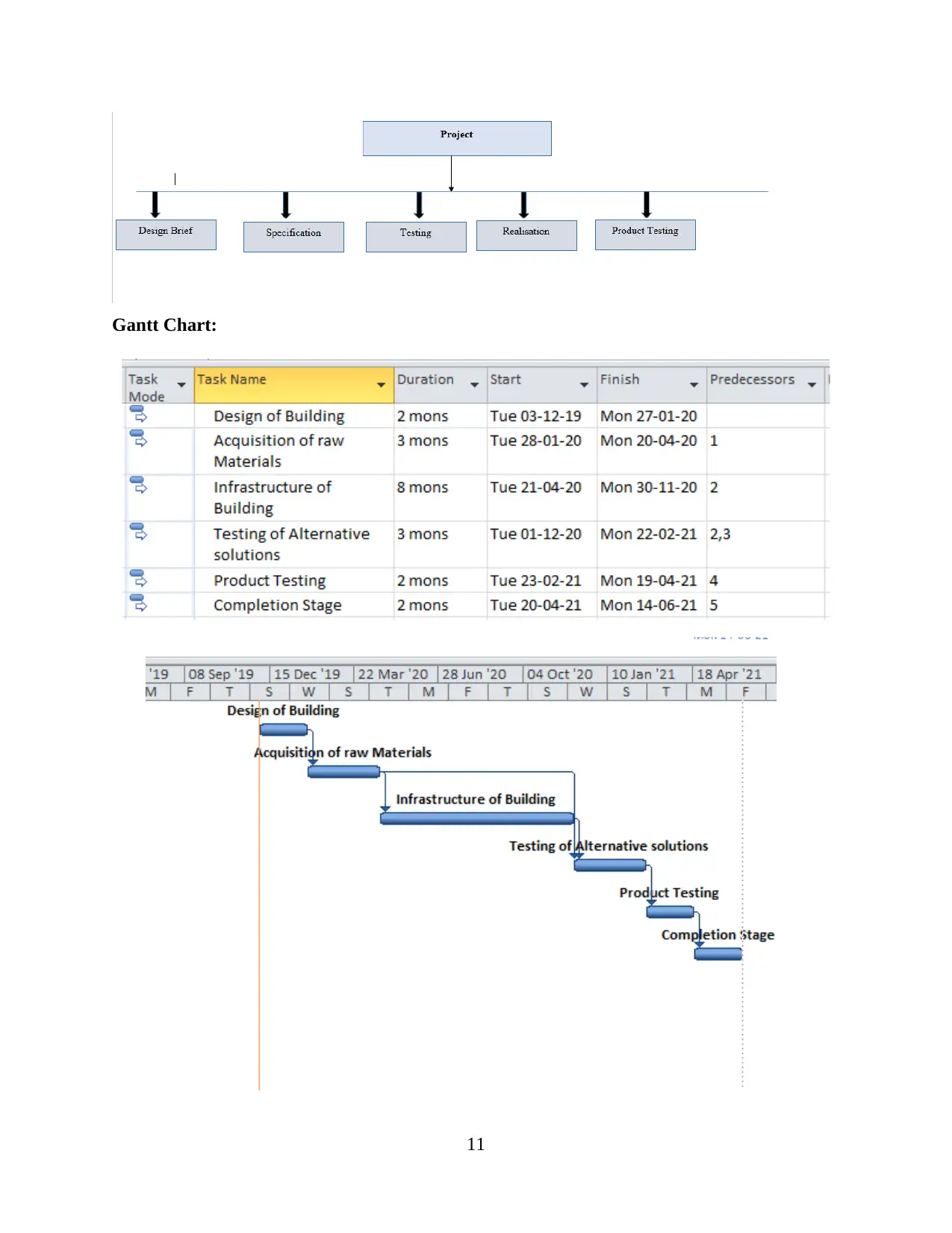
Gantt Chart:
11
11
Paraphrase This Document
Need a fresh take? Get an instant paraphrase of this document with our AI Paraphraser
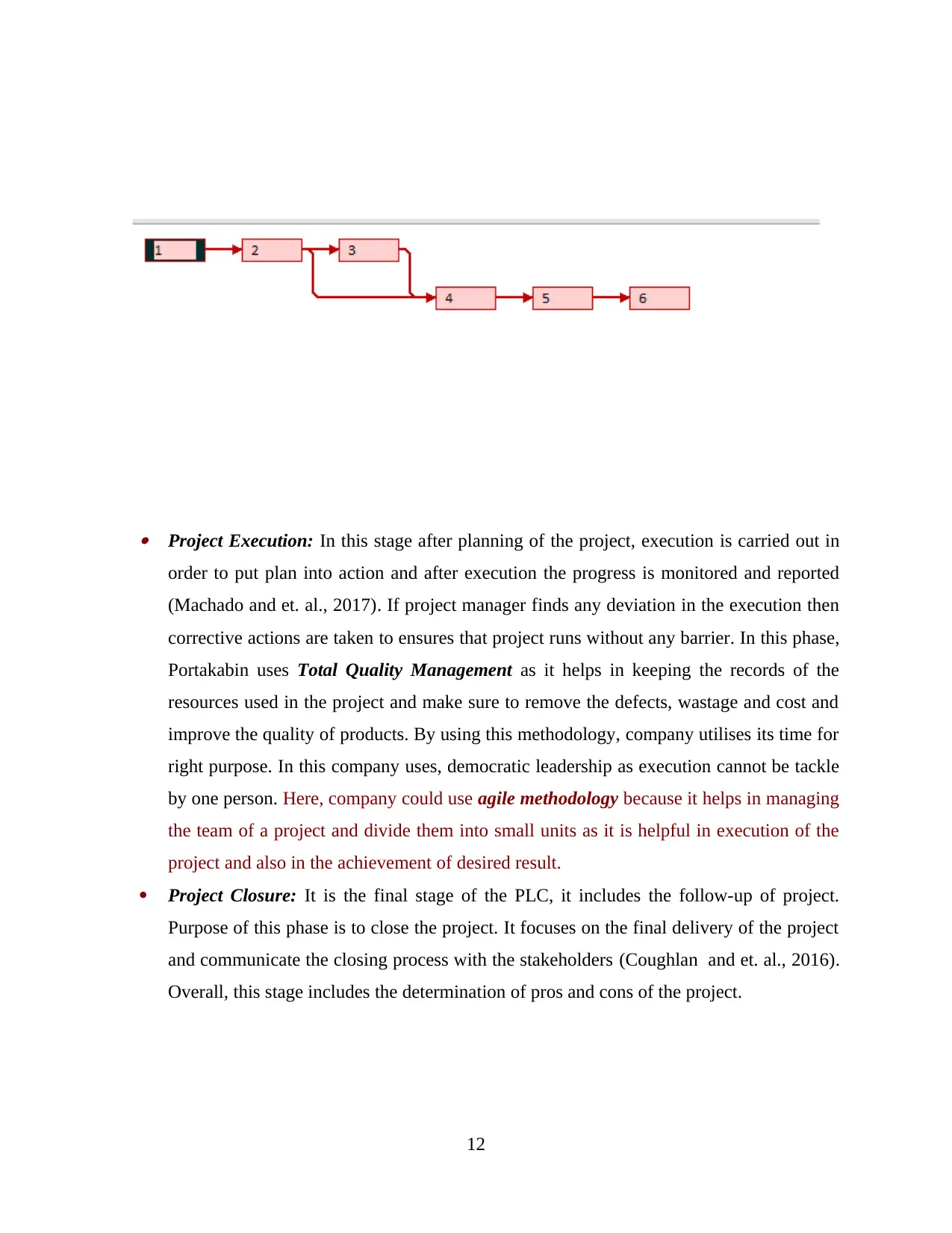
Project Execution: In this stage after planning of the project, execution is carried out in
order to put plan into action and after execution the progress is monitored and reported
(Machado and et. al., 2017). If project manager finds any deviation in the execution then
corrective actions are taken to ensures that project runs without any barrier. In this phase,
Portakabin uses Total Quality Management as it helps in keeping the records of the
resources used in the project and make sure to remove the defects, wastage and cost and
improve the quality of products. By using this methodology, company utilises its time for
right purpose. In this company uses, democratic leadership as execution cannot be tackle
by one person. Here, company could use agile methodology because it helps in managing
the team of a project and divide them into small units as it is helpful in execution of the
project and also in the achievement of desired result.
Project Closure: It is the final stage of the PLC, it includes the follow-up of project.
Purpose of this phase is to close the project. It focuses on the final delivery of the project
and communicate the closing process with the stakeholders (Coughlan and et. al., 2016).
Overall, this stage includes the determination of pros and cons of the project.
12
order to put plan into action and after execution the progress is monitored and reported
(Machado and et. al., 2017). If project manager finds any deviation in the execution then
corrective actions are taken to ensures that project runs without any barrier. In this phase,
Portakabin uses Total Quality Management as it helps in keeping the records of the
resources used in the project and make sure to remove the defects, wastage and cost and
improve the quality of products. By using this methodology, company utilises its time for
right purpose. In this company uses, democratic leadership as execution cannot be tackle
by one person. Here, company could use agile methodology because it helps in managing
the team of a project and divide them into small units as it is helpful in execution of the
project and also in the achievement of desired result.
Project Closure: It is the final stage of the PLC, it includes the follow-up of project.
Purpose of this phase is to close the project. It focuses on the final delivery of the project
and communicate the closing process with the stakeholders (Coughlan and et. al., 2016).
Overall, this stage includes the determination of pros and cons of the project.
12
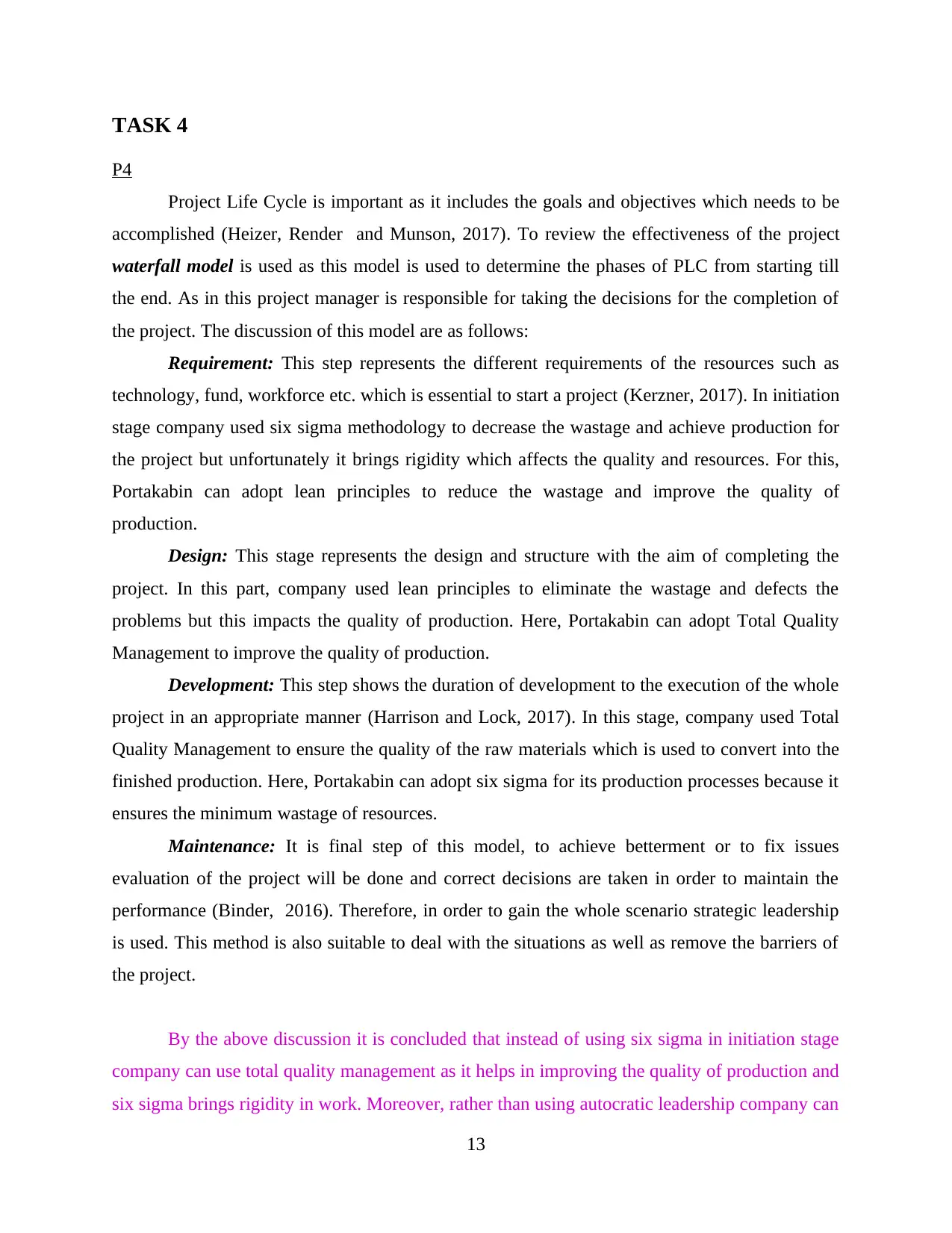
TASK 4
P4
Project Life Cycle is important as it includes the goals and objectives which needs to be
accomplished (Heizer, Render and Munson, 2017). To review the effectiveness of the project
waterfall model is used as this model is used to determine the phases of PLC from starting till
the end. As in this project manager is responsible for taking the decisions for the completion of
the project. The discussion of this model are as follows:
Requirement: This step represents the different requirements of the resources such as
technology, fund, workforce etc. which is essential to start a project (Kerzner, 2017). In initiation
stage company used six sigma methodology to decrease the wastage and achieve production for
the project but unfortunately it brings rigidity which affects the quality and resources. For this,
Portakabin can adopt lean principles to reduce the wastage and improve the quality of
production.
Design: This stage represents the design and structure with the aim of completing the
project. In this part, company used lean principles to eliminate the wastage and defects the
problems but this impacts the quality of production. Here, Portakabin can adopt Total Quality
Management to improve the quality of production.
Development: This step shows the duration of development to the execution of the whole
project in an appropriate manner (Harrison and Lock, 2017). In this stage, company used Total
Quality Management to ensure the quality of the raw materials which is used to convert into the
finished production. Here, Portakabin can adopt six sigma for its production processes because it
ensures the minimum wastage of resources.
Maintenance: It is final step of this model, to achieve betterment or to fix issues
evaluation of the project will be done and correct decisions are taken in order to maintain the
performance (Binder, 2016). Therefore, in order to gain the whole scenario strategic leadership
is used. This method is also suitable to deal with the situations as well as remove the barriers of
the project.
By the above discussion it is concluded that instead of using six sigma in initiation stage
company can use total quality management as it helps in improving the quality of production and
six sigma brings rigidity in work. Moreover, rather than using autocratic leadership company can
13
P4
Project Life Cycle is important as it includes the goals and objectives which needs to be
accomplished (Heizer, Render and Munson, 2017). To review the effectiveness of the project
waterfall model is used as this model is used to determine the phases of PLC from starting till
the end. As in this project manager is responsible for taking the decisions for the completion of
the project. The discussion of this model are as follows:
Requirement: This step represents the different requirements of the resources such as
technology, fund, workforce etc. which is essential to start a project (Kerzner, 2017). In initiation
stage company used six sigma methodology to decrease the wastage and achieve production for
the project but unfortunately it brings rigidity which affects the quality and resources. For this,
Portakabin can adopt lean principles to reduce the wastage and improve the quality of
production.
Design: This stage represents the design and structure with the aim of completing the
project. In this part, company used lean principles to eliminate the wastage and defects the
problems but this impacts the quality of production. Here, Portakabin can adopt Total Quality
Management to improve the quality of production.
Development: This step shows the duration of development to the execution of the whole
project in an appropriate manner (Harrison and Lock, 2017). In this stage, company used Total
Quality Management to ensure the quality of the raw materials which is used to convert into the
finished production. Here, Portakabin can adopt six sigma for its production processes because it
ensures the minimum wastage of resources.
Maintenance: It is final step of this model, to achieve betterment or to fix issues
evaluation of the project will be done and correct decisions are taken in order to maintain the
performance (Binder, 2016). Therefore, in order to gain the whole scenario strategic leadership
is used. This method is also suitable to deal with the situations as well as remove the barriers of
the project.
By the above discussion it is concluded that instead of using six sigma in initiation stage
company can use total quality management as it helps in improving the quality of production and
six sigma brings rigidity in work. Moreover, rather than using autocratic leadership company can
13
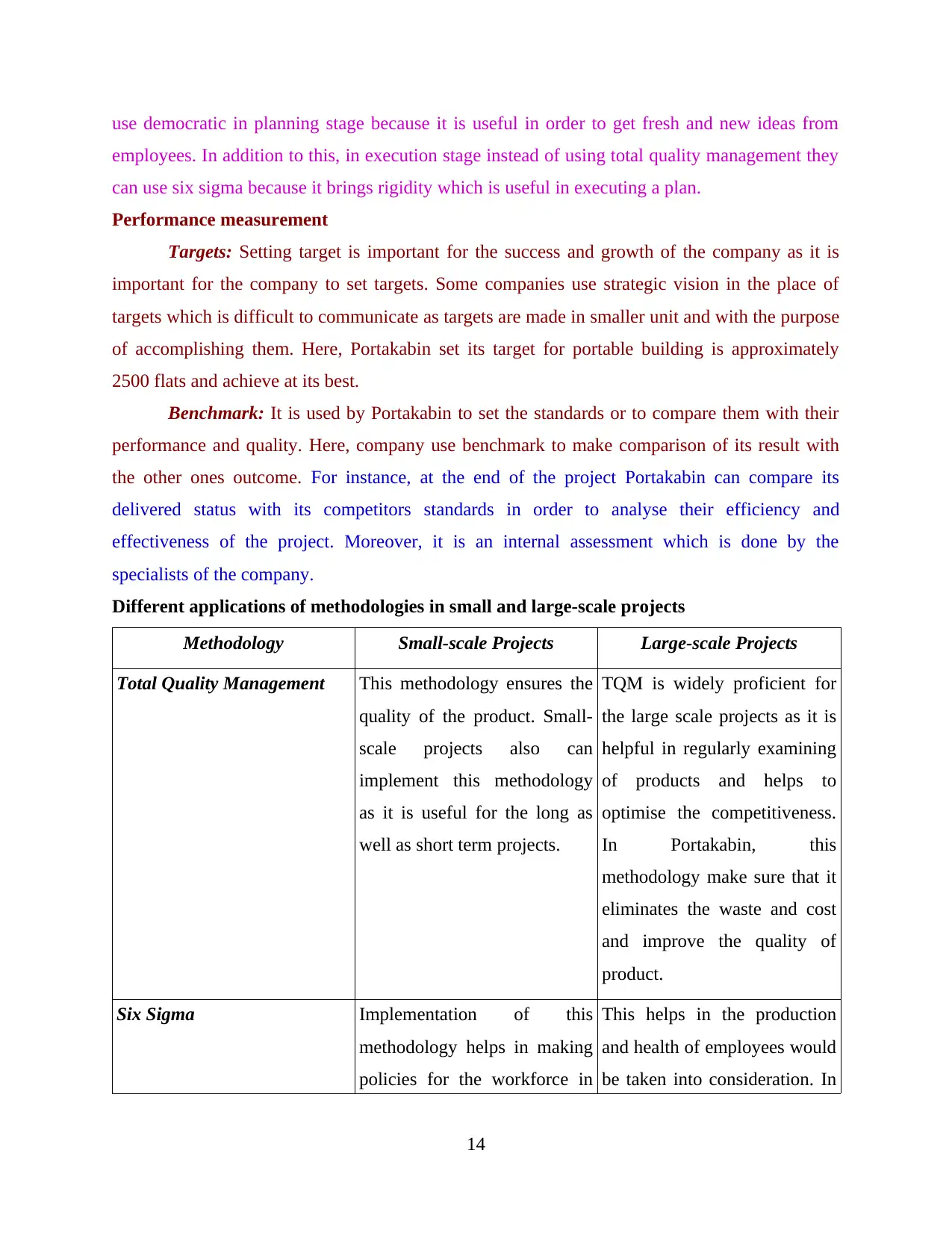
use democratic in planning stage because it is useful in order to get fresh and new ideas from
employees. In addition to this, in execution stage instead of using total quality management they
can use six sigma because it brings rigidity which is useful in executing a plan.
Performance measurement
Targets: Setting target is important for the success and growth of the company as it is
important for the company to set targets. Some companies use strategic vision in the place of
targets which is difficult to communicate as targets are made in smaller unit and with the purpose
of accomplishing them. Here, Portakabin set its target for portable building is approximately
2500 flats and achieve at its best.
Benchmark: It is used by Portakabin to set the standards or to compare them with their
performance and quality. Here, company use benchmark to make comparison of its result with
the other ones outcome. For instance, at the end of the project Portakabin can compare its
delivered status with its competitors standards in order to analyse their efficiency and
effectiveness of the project. Moreover, it is an internal assessment which is done by the
specialists of the company.
Different applications of methodologies in small and large-scale projects
Methodology Small-scale Projects Large-scale Projects
Total Quality Management This methodology ensures the
quality of the product. Small-
scale projects also can
implement this methodology
as it is useful for the long as
well as short term projects.
TQM is widely proficient for
the large scale projects as it is
helpful in regularly examining
of products and helps to
optimise the competitiveness.
In Portakabin, this
methodology make sure that it
eliminates the waste and cost
and improve the quality of
product.
Six Sigma Implementation of this
methodology helps in making
policies for the workforce in
This helps in the production
and health of employees would
be taken into consideration. In
14
employees. In addition to this, in execution stage instead of using total quality management they
can use six sigma because it brings rigidity which is useful in executing a plan.
Performance measurement
Targets: Setting target is important for the success and growth of the company as it is
important for the company to set targets. Some companies use strategic vision in the place of
targets which is difficult to communicate as targets are made in smaller unit and with the purpose
of accomplishing them. Here, Portakabin set its target for portable building is approximately
2500 flats and achieve at its best.
Benchmark: It is used by Portakabin to set the standards or to compare them with their
performance and quality. Here, company use benchmark to make comparison of its result with
the other ones outcome. For instance, at the end of the project Portakabin can compare its
delivered status with its competitors standards in order to analyse their efficiency and
effectiveness of the project. Moreover, it is an internal assessment which is done by the
specialists of the company.
Different applications of methodologies in small and large-scale projects
Methodology Small-scale Projects Large-scale Projects
Total Quality Management This methodology ensures the
quality of the product. Small-
scale projects also can
implement this methodology
as it is useful for the long as
well as short term projects.
TQM is widely proficient for
the large scale projects as it is
helpful in regularly examining
of products and helps to
optimise the competitiveness.
In Portakabin, this
methodology make sure that it
eliminates the waste and cost
and improve the quality of
product.
Six Sigma Implementation of this
methodology helps in making
policies for the workforce in
This helps in the production
and health of employees would
be taken into consideration. In
14
Secure Best Marks with AI Grader
Need help grading? Try our AI Grader for instant feedback on your assignments.
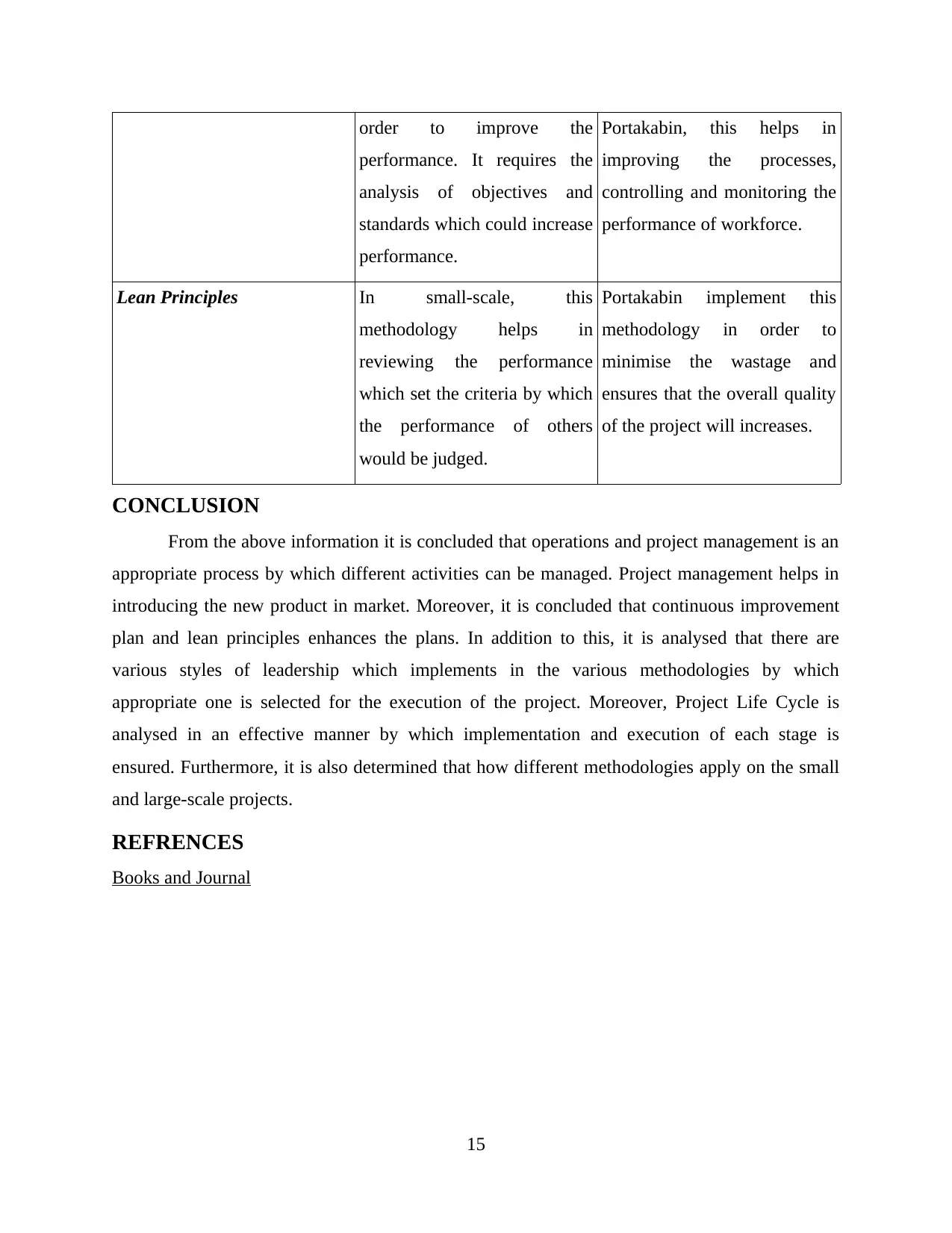
order to improve the
performance. It requires the
analysis of objectives and
standards which could increase
performance.
Portakabin, this helps in
improving the processes,
controlling and monitoring the
performance of workforce.
Lean Principles In small-scale, this
methodology helps in
reviewing the performance
which set the criteria by which
the performance of others
would be judged.
Portakabin implement this
methodology in order to
minimise the wastage and
ensures that the overall quality
of the project will increases.
CONCLUSION
From the above information it is concluded that operations and project management is an
appropriate process by which different activities can be managed. Project management helps in
introducing the new product in market. Moreover, it is concluded that continuous improvement
plan and lean principles enhances the plans. In addition to this, it is analysed that there are
various styles of leadership which implements in the various methodologies by which
appropriate one is selected for the execution of the project. Moreover, Project Life Cycle is
analysed in an effective manner by which implementation and execution of each stage is
ensured. Furthermore, it is also determined that how different methodologies apply on the small
and large-scale projects.
REFRENCES
Books and Journal
15
performance. It requires the
analysis of objectives and
standards which could increase
performance.
Portakabin, this helps in
improving the processes,
controlling and monitoring the
performance of workforce.
Lean Principles In small-scale, this
methodology helps in
reviewing the performance
which set the criteria by which
the performance of others
would be judged.
Portakabin implement this
methodology in order to
minimise the wastage and
ensures that the overall quality
of the project will increases.
CONCLUSION
From the above information it is concluded that operations and project management is an
appropriate process by which different activities can be managed. Project management helps in
introducing the new product in market. Moreover, it is concluded that continuous improvement
plan and lean principles enhances the plans. In addition to this, it is analysed that there are
various styles of leadership which implements in the various methodologies by which
appropriate one is selected for the execution of the project. Moreover, Project Life Cycle is
analysed in an effective manner by which implementation and execution of each stage is
ensured. Furthermore, it is also determined that how different methodologies apply on the small
and large-scale projects.
REFRENCES
Books and Journal
15
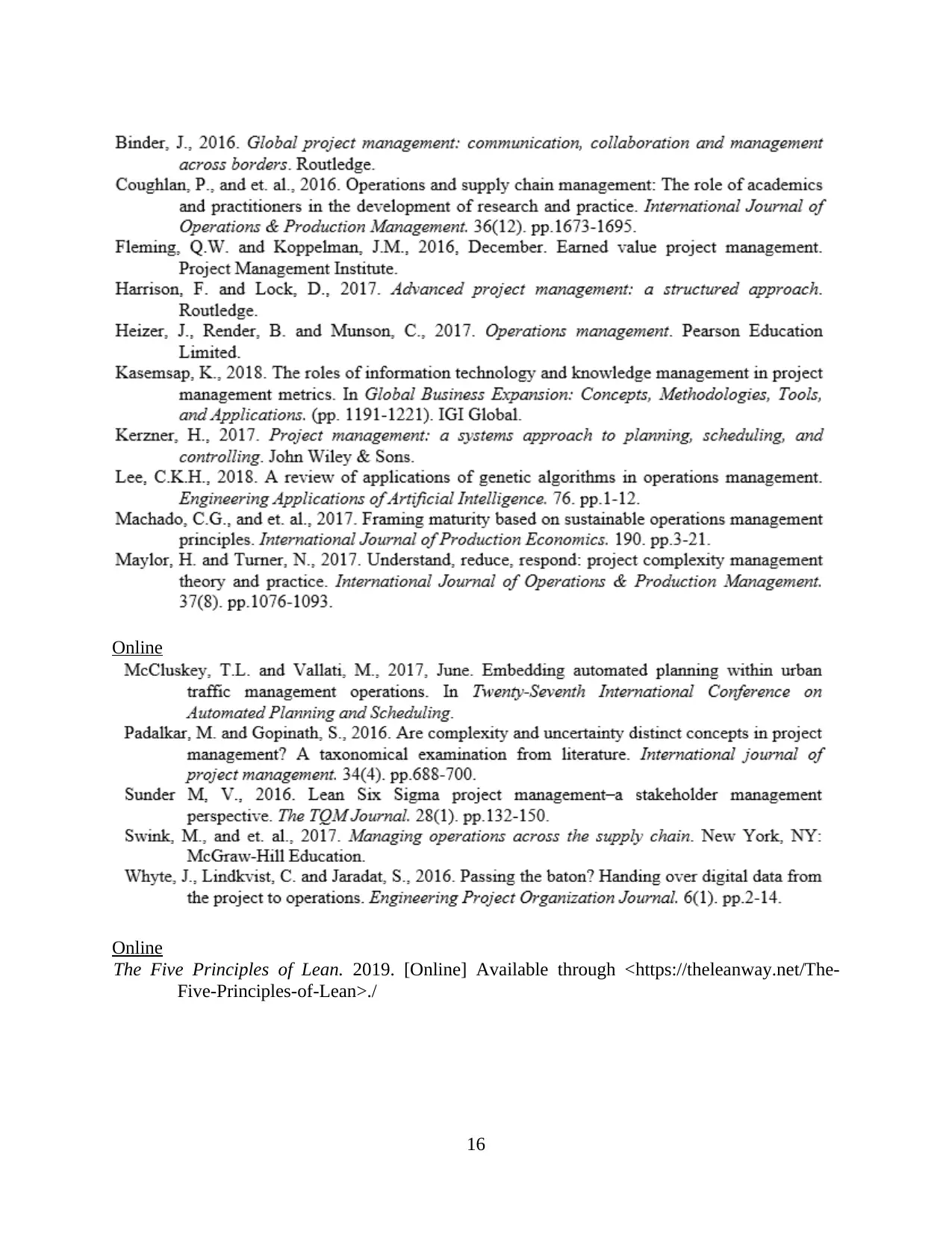
Online
Online
The Five Principles of Lean. 2019. [Online] Available through <https://theleanway.net/The-
Five-Principles-of-Lean>./
16
Online
The Five Principles of Lean. 2019. [Online] Available through <https://theleanway.net/The-
Five-Principles-of-Lean>./
16

17
1 out of 19
Related Documents
Your All-in-One AI-Powered Toolkit for Academic Success.
+13062052269
info@desklib.com
Available 24*7 on WhatsApp / Email
![[object Object]](/_next/static/media/star-bottom.7253800d.svg)
Unlock your academic potential
© 2024 | Zucol Services PVT LTD | All rights reserved.





